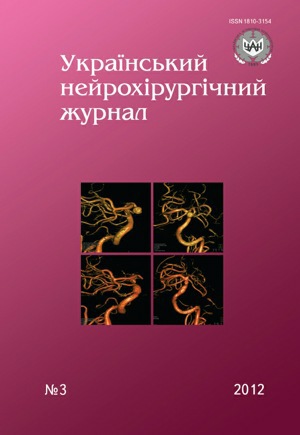The possibilities of radiosurgical treatment of cancer metastases in the brain
DOI:
https://doi.org/10.25305/unj.60844Keywords:
metastases in the brain, stereotactic radiosurgery, neurosurgery, radiotherapyAbstract
Introduction. Metastases in the brain — is the most frequent intracerebral complication and one of the main reasons of patients death at oncologic diseases.
Methods. From November, 2010 to March, 2012 (for 15 months) stereotactic radiosurgery (SRS) was conducted in 38 patients with metastasis in the brain.
Results. For 6 months after SRS from 25 patients 20 (80%) were alive, 5 (20%) died, for a year after SRS from 11 persons 8 (72.73%) were alive, 3 (27.27%) died. At local control of metastases according to MRI data in 5–6 months positive dynamics was revealed in 8 patients, the pathological centers decreased (from 0.5 to 1.8 cm), up to complete disappearance.
Conclusions. SRS — is highly effective and safe enough method for patients’ treatment at oncological pathology with metastases in the brain.
References
1. Ilyalov SR. Stereotaksicheskaya radiokhirurgiya vnutrimozgovykh metastazov raka s primeneniyem ustanovki “Leksell Gamma Knife” (obzor literatury). Moscow: OAO «Delovoy tsentr neyrokhirurgii», 2008. Russian.
2. Golanov AV, Cherekaev VA, Serova NK, Pronin IN, Gorlachev GE, Kotelnikova TM, Podoprigora AE, Kudriavtseva PA, Galkin MV. [Linear accelerator-based stereotactic radiation treatment of patients with medial middle fossa meningiomas]. Zh Vopr Neirokhir Im N N Burdenko. 2010;(1):13-18. Russian. [PubMed]
3. Dolgushin MB, Pronin IN, Korniyenko V N [et al.]. Perfuzionnaya kompyuternaya tomografiya v dinamicheskoy otsenke effektivnosti luchevoy terapii pri vtorichnom opukholevom porazhenii golovnogo mozga [Perfusion computed tomography in assessment of radiotherapy efficacy in patients with secondary brain tumors]. Vestn. RONTS im. N.N. Blokhina RAMN. 2008;19(4)36–46. Russian.
4. Galanov AV, Konovalov AN, Kornienko VN, Ilialov SR, Kostiuchenko VV, Pronin IN, Mariashev SA, Iakovlev SB, Lubnin AIu, Serova NK, Nikonova NG. [First experience with a Gamma-knife unit used for radiosurgical treatment for intracranial space-occupying lesions]. Zh Vopr Neirokhir Im N N Burdenko. 2007;(1):3-10. Russian. [PubMed]
5. Karakhan VB, Fu RG, Aleshin VA. Rol khirurgii v kombinirovannom i kompleksnom lechenii metastazov v golovnom mozge. In: Abstract Book of X Russian Oncologic Congress; 2006 November 21-23; Moscow, Russia. Moscow, 2006. p. 129-131. Russian. http://www.rosoncoweb.ru/library/congress/ru/10/46.php
6. Ewend M, Elbabaa S, Carey L. Current treatment paradigms for the management of patients with brain metastases. Neurosurgery. 2005;57(SUPPLEMENT):66-77. [CrossRef] [PubMed]
7. Aoyama H, Shirato H, Tago M, Nakagawa K, Toyoda T, Hatano K, Kenjyo M, Oya N, Hirota S, Shioura H, Kunieda E, Inomata T, Hayakawa K, Katoh N, Kobashi G. Stereotactic Radiosurgery Plus Whole-Brain Radiation Therapy vs Stereotactic Radiosurgery Alone for Treatment of Brain Metastases. JAMA. 2006;295(21):2483-2491. [CrossRef] [PubMed]
8. Brem S, Panattil JG. An era of rapid advancement: diagnosis and treatment of metastatic brain cancer. Neurosurgery. 2005;57(5 Suppl):5-9. [PubMed]
9. Jagannathan J, Petit J, Balsara K, Hudes R, Chin L. Long-Term Survival After Gamma Knife Radiosurgery for Primary and Metastatic Brain Tumors. American Journal of Clinical Oncology. 2004;27(5):441-444. [CrossRef] [PubMed]
10. Koc M, McGregor J, Grecula J, Bauer C, Gupta N, Gahbauer R. Gamma Knife radiosurgery for intracranial metastatic melanoma: an analysis of survival and prognostic factors. J Neurooncol. 2005;71(3):307-313. [CrossRef] [PubMed]
11. Kondziolka D, Niranjan A, Flickinger JC, Lunsford LD. Radiosurgery with or without whole-brain radiotherapy for brain metastases: the patients perspective regarding complications. Am J Clin Oncol. 2005;28(2):173-179. [PubMed]
12. Lippitz B. Gamma Knife radiosurgery in the minimal invasive treatment of brain metastases: the state-of-the-art. Riv. Med. 2005;11(1–2):31–37.
13. Lippitz BE, Kraepelien T, Hautanen K, Ritzling M, Rähn T, Ulfarsson E, Boethius J. Gamma knife radiosurgery for patients with multiple cerebral metastases. Acta Neurochir. 2004;91:79-87. [PubMed]
14. Mindermann T. Tumor recurrence and survival following gamma knife surgery for brain metastases. Journal of Neurosurgery. 2005;102(s_supplement):287-288. [CrossRef] [PubMed]
15. Muacevic A, Kreth F, Horstmann G et al. Surgery and radiotherapy compared with gamma knife radiosurgery in the treatment of solitary single cerebral metastases of small diameter. Journal of Neurosurgery. 1999;91(1):35-43. [CrossRef] [PubMed]
16. Nam T, Lee J, Jung Y et al. Gamma knife surgery for brain metastases in patients harboring four or more lesions: survival and prognostic factors. Journal of Neurosurgery. 2005;102(s_supplement):147-150. [CrossRef] [PubMed]
17. Sheehan J, Kondziolka D, Flickinger J, Lunsford L. Radiosurgery for patients with recurrent small cell lung carcinoma metastatic to the brain: outcomes and prognostic factors. Journal of Neurosurgery. 2005;102(supplement):247-254. [CrossRef] [PubMed]
18. Siomin V, Vogelbaum M, Kanner A, Lee S, Suh J, Barnett G. Posterior fossa metastases: risk of leptomeningeal disease when treated with stereotactic radiosurgery compared to surgery. J Neurooncol. 2004;67(1/2):115-121. [CrossRef] [PubMed]
19. Varlotto J, Flickinger J, Niranjan A, Bhatnagar A, Kondziolka D, Lunsford L. The impact of whole-brain radiation therapy on the long-term control and morbidity of patients surviving more than one year after gamma knife radiosurgery for brain metastases. International Journal of Radiation Oncology*Biology*Physics. 2005;62(4):1125-1132. [CrossRef]
20. Yu C, Cheung J, Chan J, Leung S, Ho R. Prolonged survival in a subgroup of patients with brain metastases treated by gamma knife surgery. Journal of Neurosurgery. 2005;102(s_supplement):262-265. [CrossRef] [PubMed]
Downloads
Published
How to Cite
Issue
Section
License
Copyright (c) 2012 Andrey Gryazov, Olga Chuvashova

This work is licensed under a Creative Commons Attribution 4.0 International License.
Ukrainian Neurosurgical Journal abides by the CREATIVE COMMONS copyright rights and permissions for open access journals.
Authors, who are published in this Journal, agree to the following conditions:
1. The authors reserve the right to authorship of the work and pass the first publication right of this work to the Journal under the terms of Creative Commons Attribution License, which allows others to freely distribute the published research with the obligatory reference to the authors of the original work and the first publication of the work in this Journal.
2. The authors have the right to conclude separate supplement agreements that relate to non-exclusive work distribution in the form of which it has been published by the Journal (for example, to upload the work to the online storage of the Journal or publish it as part of a monograph), provided that the reference to the first publication of the work in this Journal is included.









